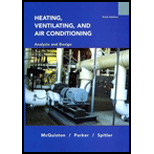
Convert the following quantities from English to SI units:
a. 98 Btu/(hr-ft-F)
b. 0.24 Btu/(lbm-F)
C. 0.04 Ibm/(ft-hr)
d. 1050 Btu/lbm
e. 1.0 ton (cooling)
f. 14.7 lbf/in.2
(a)
To Convert:
Answer to Problem 1.1P
Thequantity in SI units is,
Explanation of Solution
Given:
The given quantity is,
Calculation:
Consider the given quantity.
Convert the quantity to SI units.
The quantity in SI units is converted as,
(b)
To convert:
Answer to Problem 1.1P
The quantity in SI units is
Explanation of Solution
Given:
The given quantity is,
Calculation:
Consider the given quantity.
Convert the quantity to SI units.
The quantity in SI units is converted as,
(c)
To convert:
Answer to Problem 1.1P
The quantity in SI units is
Explanation of Solution
Given:
The given quantity is,
Calculation:
Consider the given quantity.
Convert the quantity to SI units.
The quantity in SI units is converted as,
(d)
To convert:
Answer to Problem 1.1P
The quantity in SI units is
Explanation of Solution
Given:
The given quantity is,
Calculation:
Consider the given quantity.
Convert the quantity to SI units.
The quantity in SI units is converted as,
(e)
To convert:
Answer to Problem 1.1P
The quantity in SI units is
Explanation of Solution
Given:
The given quantity is,
Calculation:
Consider the given quantity.
Convert the quantity to SI units.
The quantity in SI units is converted as,
(f)
To convert:
Answer to Problem 1.1P
The quantity in SI units is
Explanation of Solution
Given:
The given quantity is,
Calculation:
Consider the given quantity.
Convert the quantity to SI units.
The quantity in SI units is converted as,
Want to see more full solutions like this?
Chapter 1 Solutions
Heating Ventilating and Air Conditioning: Analysis and Design
Additional Engineering Textbook Solutions
Starting Out with Java: From Control Structures through Data Structures (4th Edition) (What's New in Computer Science)
Starting Out with Python (4th Edition)
Introduction To Programming Using Visual Basic (11th Edition)
Thermodynamics: An Engineering Approach
Thinking Like an Engineer: An Active Learning Approach (4th Edition)
Starting Out with Java: From Control Structures through Objects (7th Edition) (What's New in Computer Science)
- Oxygen (molar mass 32 kg/kmol) expands reversibly in a cylinder behind a piston at a constant pressure of 3 bar. The volume initially is 0.01 m3 and finally is 0.03 m3; the initial temperature is 17°C. Calculate the work input and the heat supplied during the expansion. Assume oxygen to be an ideal gas and take cp = 0.917 kJ/kg K. For 1 bonus mark explain why (using your understanding of thermodynamics) that oxygen is used in this context rather than water vapour.arrow_forwardHydrodynamic Lubrication Theory Q1: Convert this equations into Python by 1- ah ap a h³ ap 1..ah = ax 12μ ax ay 12μ ay 2 ax Where P=P(x, y) is the oil film pressure. 2- 3μU (L² ε sin P= C²R (1+ cos 0)³ Q2: prove that |h(0) = C(1+ cos 0) ?arrow_forward### To make a conclusion for a report of an experiment on rockets, in which the openrocket software was used for the construction and modeling of two rockets: one one-stage and one two-stage. First rocket (single-stage) reached a maximum vertical speed of 200 m/s and a maximum height of 1000 m The second rocket (two-stage) reached a maximum vertical speed of 250 m/s and a maximum height of 1800 m To make a simplified conclusion, taking into account the efficiency of the software in the study of rocketsarrow_forward
- What is the difference between saturated liquid and compressed liquid? What is the difference between the critical point and the triple pointarrow_forwardWhat is quality? Does it have any meaning in the superheated vapour region? What is the difference between saturated vapor and superheated vapour? What is the difference between saturated liquid and compressed liquid? What is the difference between the critical point and the triple point?arrow_forwardHomework#5arrow_forward
- Describe the principle operation of PEMFC, and role of membrane electrode assembly (MEA).arrow_forwardHomework#5arrow_forwardUsing graphical methods, draw the pressure angle at the position shown in (a) and (b). e |------- R = Cam Base Radius e = Follower Offset ẞ₁ = Section Duration 1 B₁ = Section Duration 2 ẞ₂ = Section Duration 3 В2 B₁ Follower Position ww R ẞ3 (a) Reference Radial (b)arrow_forward
 Refrigeration and Air Conditioning Technology (Mi...Mechanical EngineeringISBN:9781305578296Author:John Tomczyk, Eugene Silberstein, Bill Whitman, Bill JohnsonPublisher:Cengage Learning
Refrigeration and Air Conditioning Technology (Mi...Mechanical EngineeringISBN:9781305578296Author:John Tomczyk, Eugene Silberstein, Bill Whitman, Bill JohnsonPublisher:Cengage Learning
